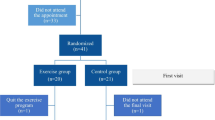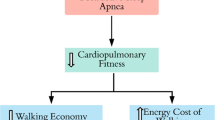Abstract
Background/objectives
Physical activity is promoted in patients with sleep disorders and obesity. The aim of the present study was to assess physiological factors influencing objectively measured spontaneous physical activity in already treated patients for obstructive sleep apnea (OSA) by nocturnal continuous positive airway pressure (CPAP).
Subjects/methods
Fifty-five patients (age = 53 ± 3 years; body mass index (BMI) = 38 ± 3 kg/m2; compliance with CPAP >4 h/night) were prospectively included. Measurements were 5-day actigraphy with metabolic equivalent of task (METs) assessment, body composition, pulmonary function, quadriceps and respiratory muscle strength, exercise capacity (6-min walking distance and maximal aerobic capacity), as well as sleep parameters (sleepiness, duration, oxygen saturation, and micro-arousals during sleep) and quality of life (SF-36 questionnaire).
Results
As expected, the number of steps per day (6879 ± 2511) and mean intensity of physical activity (1.38 ± 0.15 METs) were below the recommendations for obese population. In age-adjusted stepwise regression models, peak oxygen consumption (VO2 peak) and peak dyspnea perception during incremental exercise test were independent predictors of the number of steps per day (r = 0.49, p = 0.001) although VO2 peak and peak minute ventilation were independent predictors of intensity of physical activity (in METs/day; r = 0.49, p = 0.001).
Conclusions
In severe obese patients with OSA, exercise capacity, ventilatory requirement, and dyspnea perception were main physiological components of physical activity. These results emphasize the need to consider specific training interventions that increase ability to perform intense physical activity in obese OSA.



Similar content being viewed by others
References
Pepin JL, Tamisier R, Levy P (2012) Obstructive sleep apnoea and metabolic syndrome: put CPAP efficacy in a more realistic perspective. Thorax 67(12):1025–1027. doi:10.1136/thoraxjnl-2012-202807
Jullian-Desayes I, Joyeux-Faure M, Tamisier R, Launois S, Borel AL, Levy P, Pepin JL (2015) Impact of obstructive sleep apnea treatment by continuous positive airway pressure on cardiometabolic biomarkers: a systematic review from sham CPAP randomized controlled trials. Sleep Med Rev 21:23–38. doi:10.1016/j.smrv.2014.07.004
Igelstrom H, Emtner M, Lindberg E, Asenlof P (2013) Physical activity and sedentary time in persons with obstructive sleep apnea and overweight enrolled in a randomized controlled trial for enhanced physical activity and healthy eating. Sleep Breath 17(4):1257–1266. doi:10.1007/s11325-013-0831-6
Mendelson M, Tamisier R, Laplaud D, Dias-Domingos S, Baguet JP, Moreau L, Koltes C, Chavez L, de Lamberterie G, Herengt F, Levy P, Flore P, Pepin JL (2013) Low physical activity is a determinant for elevated blood pressure in high cardiovascular risk obstructive sleep apnea. Respir Care. doi:10.4187/respcare.02948
Verwimp J, Ameye L, Bruyneel M (2013) Correlation between sleep parameters, physical activity and quality of life in somnolent moderate to severe obstructive sleep apnea adult patients. Sleep Breath 17(3):1039–1046. doi:10.1007/s11325-012-0796-x
Gibala MJ, Little JP, Macdonald MJ, Hawley JA (2012) Physiological adaptations to low-volume, high-intensity interval training in health and disease. J Physiol 590(Pt 5):1077–1084. doi:10.1113/jphysiol.2011.224725
West SD, Kohler M, Nicoll DJ, Stradling JR (2009) The effect of continuous positive airway pressure treatment on physical activity in patients with obstructive sleep apnoea: a randomised controlled trial. Sleep Med 10(9):1056–1058
Vanhecke TE, Franklin BA, Zalesin KC, Sangal RB, deJong AT, Agrawal V, McCullough PA (2008) Cardiorespiratory fitness and obstructive sleep apnea syndrome in morbidly obese patients. Chest 134(3):539–545. doi:10.1378/chest.08-0567
Wilms B, Ernst B, Thurnheer M, Weisser B, Schultes B (2014) Correction factors for the calculation of metabolic equivalents (MET) in overweight to extremely obese subjects. Int J Obes 38(11):1383–1387. doi:10.1038/ijo.2014.22
Byrne NM, Hills AP, Hunter GR, Weinsier RL (1985) Schutz Y (2005) metabolic equivalent: one size does not fit all. J Appl Physiol 99(3):1112–1119. doi:10.1152/japplphysiol.00023.2004
Miller MR, Crapo R, Hankinson J, Brusasco V, Burgos F, Casaburi R, Coates A, Enright P, van der Grinten CP, Gustafsson P, Jensen R, Johnson DC, MacIntyre N, McKay R, Navajas D, Pedersen OF, Pellegrino R, Viegi G, Wanger J (2005) General considerations for lung function testing. Eur Respir J 26(1):153–161
European Society of Hypertension-European Society of Cardiology guidelines for the management of arterial hypertension (2003) J Hypertens 21(6):1011–1053
Allaire J, Maltais F, Doyon JF, Noel M, LeBlanc P, Carrier G, Simard C, Jobin J (2004) Peripheral muscle endurance and the oxidative profile of the quadriceps in patients with COPD. Thorax 59(8):673–678
American Thoracic Society/European Respiratory S (2002) ATS/ERS statement on respiratory muscle testing. Am J Respir Crit Care Med 166(4):518–624. doi:10.1164/rccm.166.4.518
ATS statement: guidelines for the six-minute walk test (2002) Am J Respir Crit Care Med 166 (1):111–117
Tudor-Locke C (2010) Steps to better cardiovascular health: how many steps does it take to achieve good health and how confident are we in this number? Curr Cardiovasc Risk Rep 4(4):271–276. doi:10.1007/s12170-010-0109-5
Sedentary Behaviour Research N (2012) Standardized use of the terms “sedentary” and “sedentary behaviours”. Appl Physiol Nutr Metab 37(3):540–545. doi:10.1139/h2012-024
Sedentary Behaviour Research N (2012) Letter to the editor: standardized use of the terms “sedentary” and “sedentary behaviours”. Applied physiology, nutrition, and metabolism = Physiologie appliquee, nutrition et metabolisme 37(3):540–542. doi:10.1139/h2012-024
Gillen JB, Percival ME, Ludzki A, Tarnopolsky MA, Gibala MJ (2013) Interval training in the fed or fasted state improves body composition and muscle oxidative capacity in overweight women. Obesity 21(11):2249–2255. doi:10.1002/oby.20379
Heydari M, Freund J, Boutcher SH (2012) The effect of high-intensity intermittent exercise on body composition of overweight young males. J Obes 2012:480467. doi:10.1155/2012/480467
Little JP, Gillen JB, Percival ME, Safdar A, Tarnopolsky MA, Punthakee Z, Jung ME (1985) Gibala MJ (2011) low-volume high-intensity interval training reduces hyperglycemia and increases muscle mitochondrial capacity in patients with type 2 diabetes. J Appl Physiol 111(6):1554–1560. doi:10.1152/japplphysiol.00921.2011
Tjonna AE, Lee SJ, Rognmo O, Stolen TO, Bye A, Haram PM, Loennechen JP, Al-Share QY, Skogvoll E, Slordahl SA, Kemi OJ, Najjar SM, Wisloff U (2008) Aerobic interval training versus continuous moderate exercise as a treatment for the metabolic syndrome: a pilot study. Circulation 118(4):346–354. doi:10.1161/CIRCULATIONAHA.108.772822
Rognmo O, Hetland E, Helgerud J, Hoff J, Slordahl SA (2004) High intensity aerobic interval exercise is superior to moderate intensity exercise for increasing aerobic capacity in patients with coronary artery disease. European Journal of Cardiovascular Prevention and Rehabilitation: Official Journal of the European Society of Cardiology, Working Groups on Epidemiology & Prevention and Cardiac Rehabilitation and Exercise Physiology 11(3):216–222
Whyte LJ, Gill JM, Cathcart AJ (2010) Effect of 2 weeks of sprint interval training on health-related outcomes in sedentary overweight/obese men. Metab Clin Exp 59(10):1421–1428. doi:10.1016/j.metabol.2010.01.002
Wisloff U, Stoylen A, Loennechen JP, Bruvold M, Rognmo O, Haram PM, Tjonna AE, Helgerud J, Slordahl SA, Lee SJ, Videm V, Bye A, Smith GL, Najjar SM, Ellingsen O, Skjaerpe T (2007) Superior cardiovascular effect of aerobic interval training versus moderate continuous training in heart failure patients: a randomized study. Circulation 115(24):3086–3094. doi:10.1161/CIRCULATIONAHA.106.675041
Kodama S, Saito K, Tanaka S, Maki M, Yachi Y, Asumi M, Sugawara A, Totsuka K, Shimano H, Ohashi Y, Yamada N, Sone H (2009) Cardiorespiratory fitness as a quantitative predictor of all-cause mortality and cardiovascular events in healthy men and women: a meta-analysis. JAMA 301(19):2024–2035. doi:10.1001/jama.2009.681
Villiot-Danger JC, Villiot-Danger E, Borel JC, Pepin JL, Wuyam B, Verges S Respiratory muscle endurance training in obese patients. Int J Obes 35(5):692–699
Dreher M, Kabitz HJ, Burgardt V, Walterspacher S, Windisch W (2009) Proportional assist ventilation improves exercise capacity in patients with obesity. Respiration
Author information
Authors and Affiliations
Corresponding author
Ethics declarations
Funding
Foundation Agir Pour les Maladies Chroniques (APMC), Meylan, France, and Philips Respironics, France, provided financial support in the form of grant funding. The sponsor had no role in the design or conduct of this research.
Conflict of interest
All authors certify that they have no affiliations with or involvement in any organization or entity with any financial interest (such as honoraria; educational grants; participation in speakers’ bureaus; membership, employment, consultancies, stock ownership, or other equity interest; and expert testimony or patent-licensing arrangements) or non-financial interest (such as personal or professional relationships, affiliations, knowledge, or beliefs) in the subject matter or materials discussed in this manuscript.
Ethical approval
All procedures performed in studies involving human participants were in accordance with the ethical standards of the institutional and/or national research committee and with the 1964 Helsinki declaration and its later amendments or comparable ethical standards.
Informed consent
Informed consent was obtained from all individual participants included in the study.
Rights and permissions
About this article
Cite this article
Vivodtzev, I., Mendelson, M., Croteau, M. et al. Physiological correlates to spontaneous physical activity variability in obese patients with already treated sleep apnea syndrome. Sleep Breath 21, 61–68 (2017). https://doi.org/10.1007/s11325-016-1368-2
Received:
Revised:
Accepted:
Published:
Issue Date:
DOI: https://doi.org/10.1007/s11325-016-1368-2




